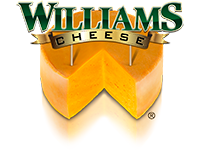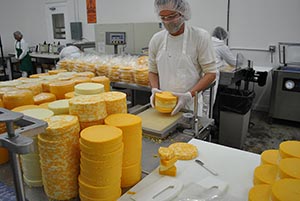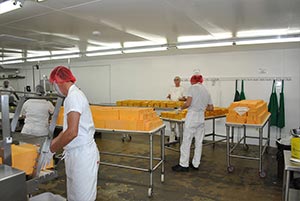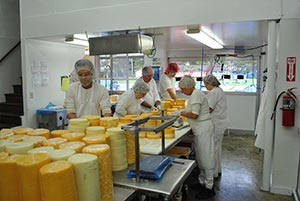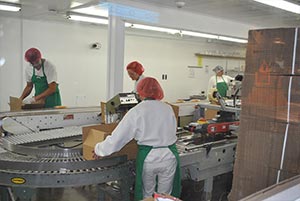Three types of bacteria are used in the production of Emmental cheese: Streptococcus salivarius subspecies thermophilus, Lactobacillus (Lactobacillus helveticus or Lactobacillus delbrueckii subspecies bulgaricus), and Propionibacterium (Propionibacterium freudenreichii subspecies shermani). In a late stage of cheese production, the propionibacteria consume the lactic acid excreted by the other bacteria and release acetate, propionic acid, and carbon dioxide gas. The carbon dioxide slowly forms the bubbles that develop the “eyes”. The acetate and propionic acid give Swiss its nutty and sweet flavor.
SWISS CHEESE
Williams Swiss Cheese
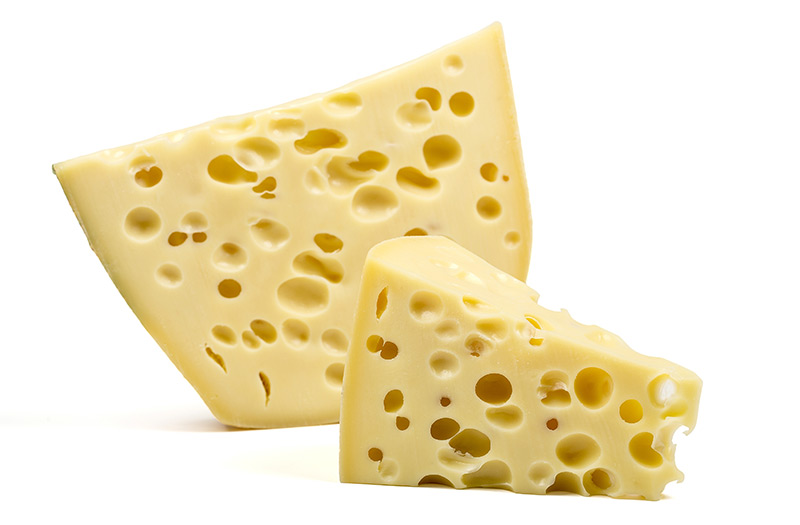

Historically, the holes were seen as a sign of imperfection and cheese makers originally tried to avoid them by pressing during production. In modern times, the holes have become an identifier of the cheese.
In general, the larger the eyes in a Swiss cheese, the more pronounced its flavor because a longer fermentation period gives the bacteria more time to act. This poses a problem, however, because cheese with large eyes does not slice well and comes apart in mechanical slicers. As a result, industry regulators have limited the eye size by which Swiss cheese receives the Grade A stamp.
Baby Swiss and Lacy Swiss are two varieties of American Swiss cheeses. Both have small holes and a mild flavor. Baby Swiss is made from whole milk, and Lacy Swiss is made from low fat milk. Baby Swiss was developed in the mid-1960s outside of Charm, Ohio, by the Guggisberg Cheese Company, owned by Alfred Guggisberg.
Williams Swiss Cheese
Three types of bacteria are used in the production of Emmental cheese: Streptococcus salivarius subspecies thermophilus, Lactobacillus (Lactobacillus helveticus or Lactobacillus delbrueckii subspecies bulgaricus), and Propionibacterium (Propionibacterium freudenreichii subspecies shermani). In a late stage of cheese production, the propionibacteria consume the lactic acid excreted by the other bacteria and release acetate, propionic acid, and carbon dioxide gas. The carbon dioxide slowly forms the bubbles that develop the “eyes”. The acetate and propionic acid give Swiss its nutty and sweet flavor.
Historically, the holes were seen as a sign of imperfection and cheese makers originally tried to avoid them by pressing during production. In modern times, the holes have become an identifier of the cheese.
In general, the larger the eyes in a Swiss cheese, the more pronounced its flavor because a longer fermentation period gives the bacteria more time to act. This poses a problem, however, because cheese with large eyes does not slice well and comes apart in mechanical slicers. As a result, industry regulators have limited the eye size by which Swiss cheese receives the Grade A stamp.
Baby Swiss and Lacy Swiss are two varieties of American Swiss cheeses. Both have small holes and a mild flavor. Baby Swiss is made from whole milk, and Lacy Swiss is made from low fat milk. Baby Swiss was developed in the mid-1960s outside of Charm, Ohio, by the Guggisberg Cheese Company, owned by Alfred Guggisberg.

A Team Effort
Williams Cheese Co. completely guarantees it’s product in addition to offering attractive margins for the retailer. In this fast growing product category our goal is to increase the Williams Cheese share of the market and however possible, position the retailer as the place to find Williams quality products.
